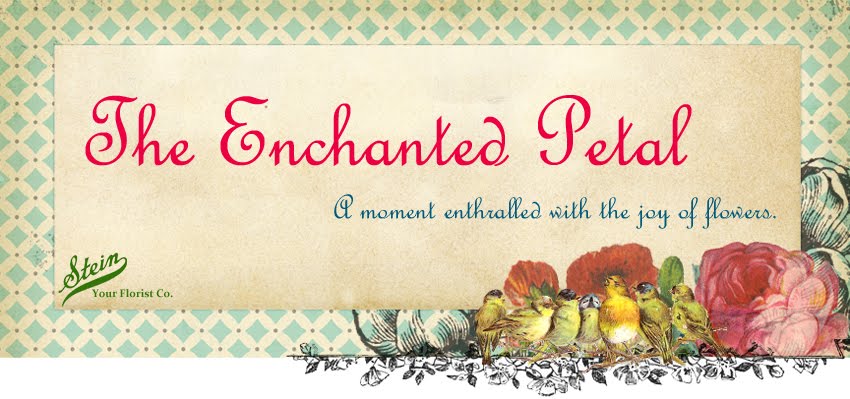 |
| Nature's Bones |
For this year’s April 26th event five talented
Stein Your Florist Co. designers, as well as several more of the Philadelphia
area’s floral artists exhibited their floriated interpretations of a variety of
masterfully created paintings and mixed media art pieces at the CCA’s exhibit.
Stein Your Florist Co. owner/operator and designer Patrick Kelly chose to
interpret “Nature’s Bones” by Paul Gorka. He created the
floral portion of his design with blue delphinium, dendrobium orchids, Spanish
moss and pothos. His design used a lot of mixed medias, awarding him Best in
Show for mixed media design. The drift wood at the base was from his own
backyard as well as the tall pussy willow branches. The tree branches and small
pinecones were gathered from the grounds around the art center, the stones were
from the pond in our flower shop, the large pinecones were from a trip to Yosemite
State Park and the resin skull was a local flea market find. Patrick had a
wonderful time creating his piece and said that the painting was the first one
to catch his eye upon entering the art center.
 |
| Untitled 1 |
Stein Your Florist Co. designer George Emberger chose to
interpret “Untitled 1” by Edwina Brennan. He said he was drawn to the pops of
natural color and wispy freedom juxtaposed to the linear grid work in the
design. George constructed his own three-dimensional grid of river cane with
floral bursts of color in roses, tulips, pincushion protea, solidego, Spanish
moss, ferns, seeded eucalyptus, and sprays of bear grass.
 |
| Road of the Flower |
George also hosted a behind the scenes seminar before the
main Art in Bloom exhibit. He did a live interpretation of “Road of the Flower”
by Merle Spandorfer, designing for an audience, answering questions, and
describing his interpretive process while he created his art piece. He chose a
bold black container and curvaceous black branches to make the “road” of the
painting pop in his design. The painting’s colors were picked up in the flowers
George used: ginger, gerbera daisies,
alstroemeria, chrysanthemums, leptospermum, and springeri. The painting’s
creator was there for the live demonstration and was fascinated by George’s
interpretation and design process.
 |
| Living Room - Fort Lauderdale 1995 |
 |
| Under the Microscope |
Co-operations
manager of our Burlington, NJ location, head of social media and designer
Jennifer Kelly chose to interpret “Under the Microscope” by Barbara Straussberg.
Jennifer, who has a bachelor’s degree in bioscience and biotechnology from
Drexel University, said that “this painting reminded [her] of [her] college
days in the lab, staring into a microscope at the various minute wonders of a
world we rarely get to see.” Playing on the “under the microscope” theme
Jennifer created her design as three oversized microscope slides, complete with
labels and floral specimens. The “Succulent Plantae Sp.” slide was designed
with live succulent plants, fresh cut pin cushion protea, and accented with
Spanish and reindeer moss and dried foliage. The “Amaryllis Hippeastrum, c.s.”
slide was made with roses, pincushion protea, hyacinth blooms wired as though
floral flagellum, eucalyptus, hypericum berries, tulips, cut succulents,
reindeer moss, floral pods, and a cross-section of an amaryllis bulb. Finally,
the “Punica Granatum, c.s.” slide was created with tulips, amaryllis, roses,
pincushion protea, cut succulents, ranunculus, reindeer moss, loops of
hypericum berries, Brussel sprouts, savoy cabbage, purple cabbage, and a
cross-section of a pomegranate. Jennifer had the opportunity to meet the
painting’s creator and she was blown away by her floral interpretation.
Jennifer was awarded Best in Show for Fun and Fantastic Design.
 |
| Ruby and Friends |
Our designers have been invited back to participate in the
CCA’s event once again next spring. Two weeks prior we will draw for spots to
select from the art on display and plan our designs. We are looking forward to
another inspirational affair and we hope you will join us.
Follow updates for next year's event by liking us on Facebook and following us on Twitter.
Follow updates for next year's event by liking us on Facebook and following us on Twitter.
 |
| Stein Your Florist Co. designer Jennifer Kelly adding the finishing touches to her flora interpretation of Under the Microscope |














































